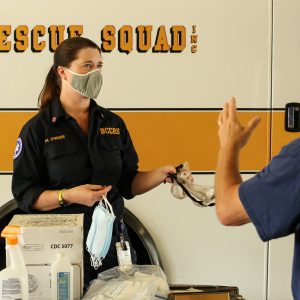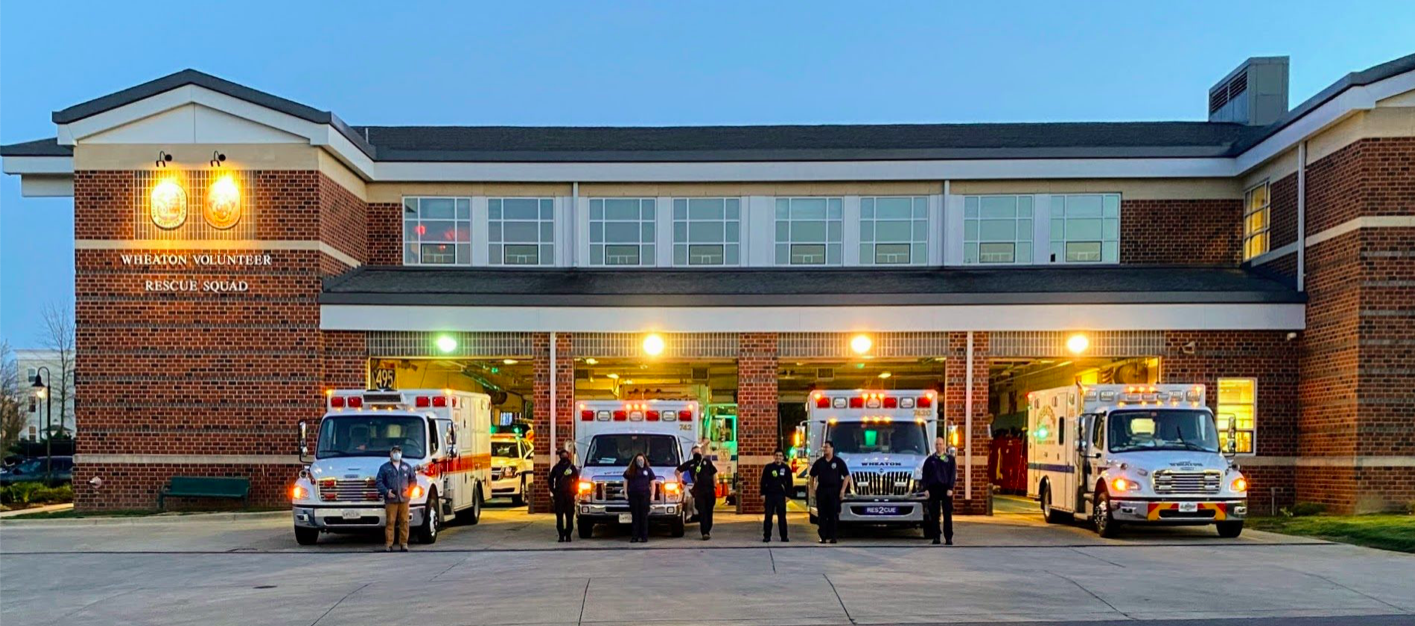
Megan O’Brien is an infectious disease epidemiologist by day, and an EMT by night at the Bethesda-Chevy Chase Rescue Squad in Maryland.
Her title is roving night crew officer and she works from 7 p.m. to 7 a.m. A volunteer at the rescue squad since 2014, O’Brien believes that it’s a way to be involved in the community and she enjoys the work.
The COVID-19 pandemic drastically altered the work for her and her fellow EMTs across the nation. They faced a unique and ever-present danger: 7% of all American frontline deaths due to the pandemic between March 2020 and April 2021 were medical first responders, according to a joint investigation by Kaiser Health News and the Guardian.
Emergency medical services workers are some of the most vulnerable front-line workers, with much of their funding and equipment dependent on the support of local government.
As the coronavirus pandemic raged last fall, a study found that “EMS personnel are at a higher risk of dying from COVID-19 than other healthcare or emergency services professionals.” COVID deaths among emergency services workers was estimated to be three times higher than among nurses and five times higher than among doctors, according to the study, published on EMS1.com, a website that serves the emergency medical services community.
As in countless other communities, O’Brien’s unit had to overhaul procedures to protect the safety of the EMTs.
O’Brien is the head of the COVID task force with the Bethesda-Chevy Chase station. She helped to develop and implement policies on COVID safety.
“Everything was really designed to try to do everything we could to protect our personnel from getting COVID and then take care of our patients as safely as we could,” O’Brien told Capital News Service.
To limit the station’s exposure to COVID, new guidelines limited the time that EMTs spent in the back of the vehicle with patients and reduced the number of personnel that could be in the station to the minimum. The squad stopped hiring new recruits and followed other requirements put in place by the Montgomery County Rescue Service.
“Montgomery County (has) been very helpful in having policies and procedures in place that we should follow to keep ourselves safe,” said EMS Lt. Jay Gruber, spokesman for the nearby Wheaton Volunteer Rescue Squad. “And they’ve been providing us a lot of PPE. The county’s been very supportive.”
Gruber, who is also the chief of police at Georgetown University and the former chief of police in College Park, Maryland, has been working with the volunteer rescue squad for 35 years.
Montgomery County Fire Rescue Service “pivoted very quickly… helping keep the community safe, and making sure that they get their needs met,” Gruber said.
Protecting the volunteers’ safety also has driven significant changes to official on-scene procedures.
“Normally, an EMS provider will wear gloves…Even during normal times, you have access to face masks, and eye protection,” Gruber explained. “With COVID… we have various types of masks that we wear for various situations. We also have mandatory use of eyewear and gowns on people who are under investigation as COVID patients and multiple layers of gloves.”
After a patient has been transported to a hospital, especially a suspected COVID patient, aggressive cleaning and decontamination of rescue squad equipment – stretchers, electronic equipment, walls, ceilings, floors – follows.
View this post on Instagram
Montgomery County’s emergency medical services system is one of the largest combined career and volunteer emergency services systems in the country, responding to over 120,000 911 calls annually, according to Dr. Meghan E. Quinn, a Navy Medical Corps lieutenant who presented a report about mental health in American volunteer fire/rescue personnel to the American Psychological Association in 2019.
Approximately half of Montgomery County’s approximately 2,500 emergency medical services workers are volunteers, Quinn said in her report.
Many communities across the nation reported that emergency services personnel were quitting or retiring because of the dangers from COVID. With the widespread administration of the anti-COVID vaccines, efforts to recruit and train new EMTs are now intensifying, according to various news reports.
In Maryland, a person can get an EMT license as early as 16 and can certify as a paramedic at 18. Rescue squad drivers must be at least 19.
Iana Sahadzic, 22, has been a volunteer paramedic with the Bethesda-Chevy Chase Rescue Squad since she was 17. She was attracted to the work after watching EMT volunteers driving down the street, lights flashing and sirens blaring, and realizing that she has always wanted to be in the health profession and help people.
While a volunteer, Sahadzic is also a student at the University of Maryland, where she studies neurobiology and physiology, with a minor in Spanish.
“Honestly, some weeks I’m not quite sure how I manage to fit everything in,” she told CNS. “I have always been a very organized person, but I think that having to balance both school and volunteering as a paramedic has forced me to manage my time much more strictly – I can’t go anywhere without my calendar.”
Sahadzic volunteers about 36 hours a week, most of which is overnight. During her down time, she brings her laptop and notebook to study or watch a lecture.
“Everyone has a different hobby and in my mind helping people in a time of need was the way I wanted to spend my free time.,” she said. “Though some days are harder than others, I am proud to have dedicated so much of my time to the community.”
One of the hardest aspects of volunteering to be an EMT during COVID is the strain on the volunteers and their loved ones.
When the pandemic was at its worst, Sahadzic said she showered multiple times before going home to visit family and followed other precautionary measures to ensure she wouldn’t bring anything home.
“I was probably trying to distance myself – because you never knew – and spend a lot more time at the fire station, because I felt like maybe, you know, the less time I spend at home the better,” she said. “But it’s gotten better with the vaccine.”
O’Brien said she slept in her guest room, away from her husband, as a precaution.
“There is a light, we can see the end, which was not the case several months ago,” she said. “I think for health care workers, things have really changed since we got vaccinated because you just don’t have that same level of fear anymore.”


You must be logged in to post a comment.